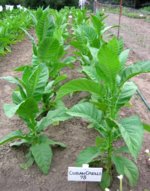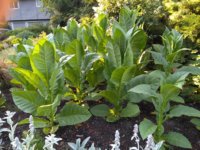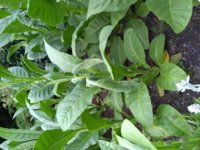You are using an out of date browser. It may not display this or other websites correctly.
You should upgrade or use an alternative browser.
You should upgrade or use an alternative browser.
MWaller 2018 Grow Blog
- Thread starter mwaller
- Start date
- Status
- Not open for further replies.
Tobacco loves plenty of rain, so long as the soil drains well. They'll do fine.
Bob
Bob
mwaller
Well-Known Member
Yeah, I'm not concerned. But I have had to stake 3 of them up!
mwaller
Well-Known Member
mwaller
Well-Known Member
HercDriver
Well-Known Member
Plants look great! Wish I had the space to do that many at once.
mwaller
Well-Known Member
My first round of orientals are starting to flower. How do I know when to start harvesting the leaves? Do orientals show the same signs of maturity as cigar varietals?
mwaller
Well-Known Member
I'll begin by saying that I have not grown Criollo 98, but only Criollo (Cuba) Ti 1376 (PI 405646): https://npgsweb.ars-grin.gov/gringlobal/accessiondetail.aspx?id=1305578Criollo 98 "Prieto" continues to impress... And it looks much different from Criollo 98 from NWTseeds. Plants on the right with long, narrow leaves are from NWTseeds. Plants in foreground on the left are Criollo 98 "Prieto."
View attachment 23973
Skychaser's photos of Criollo 98 show that the plant habitus and leaf shape closely resemble that of my Criollo Ti 1376, the difference being that the 98 version seems a bit more robust, with a higher leaf count and slightly larger leaves. But the hallmark pointed leaf shape remains similar.
Your "Criollo 98 Prieto" very closely resembles my Corojo 99, sourced directly from the Robaina plantation (where it was the only variety grown). The Corojo 99 showed the rounder, wider leaf profile, and the plants typically reached well over 6 feet in height, compared to 5 to 6' for my Criollo. My Criollo displayed a rather dark pink blossom, whereas Corojo 99 sports a light pink blossom.
So, with apologies, I suppose that I'm questioning the provenance of "Criollo 98 Prieto".
Bob
EDIT: I'll add one additional tidbit. My Criollo leaf matured fairly synchronously, enabling me to stalk-harvest it. The Corojo 99 leaves matured sequentially, requiring priming.
mwaller
Well-Known Member
Hi Bob -
No apologies needed. I will try to get more information from the guy who sourced the seeds.
I agree that they look a lot like Corojo 99. Then again, I'm not seeing much difference between your Criollo Ti 1376 and Corojo 99 other than size...
My Criollo 98 from NWTseeds looks nothing like Criollo Ti 1376 or Corojo 99, though it definitely resembles this image from NWTseeds:

This is all very mysterious to me....
No apologies needed. I will try to get more information from the guy who sourced the seeds.
I agree that they look a lot like Corojo 99. Then again, I'm not seeing much difference between your Criollo Ti 1376 and Corojo 99 other than size...
My Criollo 98 from NWTseeds looks nothing like Criollo Ti 1376 or Corojo 99, though it definitely resembles this image from NWTseeds:

This is all very mysterious to me....
mwaller
Well-Known Member
Here's a link to an article about the Prieto farm. It includes photos of the plants, which are reported to be Criollo 98. Do they look like Corojo 99 to you?
https://www.cigaraficionado.com/article/out-of-the-brick-red-soil-a-visit-to-the-prieto-farm-18643
https://www.cigaraficionado.com/article/out-of-the-brick-red-soil-a-visit-to-the-prieto-farm-18643
mwaller
Well-Known Member
I found an interesting slide presentation about the genetic improvement of tobacco in Cuba. It included this photo of Criollo 98:

Note the upturned leaf margin on a number of the leaves. I am seeing this on some of my "Prieto" plants, which is making them a bit harder to distinguish from Piloto Cubano.
Does Corojo 99 do this, too?
Interestingly, they also seem to indicate that both Corojo 99 and Criollo 98 were created by crossing ‘Habana 92’ and ‘Habana Pinar del Río’
Here's the whole presentation, in case you're interested:
https://es.slideshare.net/dcothon/mejoramiento-gentico
This website seems to corroborate the relationship between Corojo 99 and Criollo 98:
https://www.ecured.cu/Variedades_de_tabacos

Note the upturned leaf margin on a number of the leaves. I am seeing this on some of my "Prieto" plants, which is making them a bit harder to distinguish from Piloto Cubano.
Does Corojo 99 do this, too?
Interestingly, they also seem to indicate that both Corojo 99 and Criollo 98 were created by crossing ‘Habana 92’ and ‘Habana Pinar del Río’
Here's the whole presentation, in case you're interested:
https://es.slideshare.net/dcothon/mejoramiento-gentico
This website seems to corroborate the relationship between Corojo 99 and Criollo 98:
https://www.ecured.cu/Variedades_de_tabacos
mwaller
Well-Known Member
This site referenced above indicates that the average spacing between leaves of Criollo 98 is unusually small at 5cm. The average leaf spacing for Corojo 99 is 7cm. I will have to get out my ruler...
mwaller
Well-Known Member
Well, this may explain the similarity between Corojo 99 and Criollo 98:
"[FONT="]At the Experimental Tobacco Station in San Juan y Martínez, Pinar del Río, during the generation F5 of 'Criollo-98' variety a plant with leaves of larger dimensions was selected. This plant was named 'Corojo-99' and it showed resistance to blue mold (Peronospora tabacina Adam.), black shank (Phytophthora parasitica var. nicotianae) and tobacco mosaic virus (TMV). In the tobacco cropping seasons 1997-1998 and 1998-1999, a comparative study between 'Criollo-98' and the commercial varieties 'Habana-92' and 'Habana-2000', shade-grown was carried out. 'Corojo-99' produced the highest yield in wrappers for export cigars. The latter and the 'Criollo-98' surpassed the commercial varieties in relation to the total yield. The 'Corojo-99' surpassed the 'Habana-92' and 'Habana-2000' in 3 948 and 3 481 pesos for hectare, respectively."
http://agris.fao.org/agris-search/search.do?recordID=CU2010100372
[/FONT]
"[FONT="]At the Experimental Tobacco Station in San Juan y Martínez, Pinar del Río, during the generation F5 of 'Criollo-98' variety a plant with leaves of larger dimensions was selected. This plant was named 'Corojo-99' and it showed resistance to blue mold (Peronospora tabacina Adam.), black shank (Phytophthora parasitica var. nicotianae) and tobacco mosaic virus (TMV). In the tobacco cropping seasons 1997-1998 and 1998-1999, a comparative study between 'Criollo-98' and the commercial varieties 'Habana-92' and 'Habana-2000', shade-grown was carried out. 'Corojo-99' produced the highest yield in wrappers for export cigars. The latter and the 'Criollo-98' surpassed the commercial varieties in relation to the total yield. The 'Corojo-99' surpassed the 'Habana-92' and 'Habana-2000' in 3 948 and 3 481 pesos for hectare, respectively."
http://agris.fao.org/agris-search/search.do?recordID=CU2010100372
[/FONT]
This is a valuable article. Thank you. I have labored over the formal (Google) translation, edited it, and will post the text, in English, in a separate thread.This website seems to corroborate the relationship between Corojo 99 and Criollo 98:
https://www.ecured.cu/Variedades_de_tabacos
With regard to average distances between nodes, don't count on anything definitive from that. There's just too much variation from one grow-out to the next.
When you make an intentional cross of two known tobacco strains, the first generation offspring (F[sub]1[/sub]) consists of a hodgepodge of offspring, exhibiting all sorts of combinations of the various dominant and recessive traits of the two parents. The agronomist must make choices from those gazillion F[sub]1[/sub] plants, based on appearance, demonstrated resistance to various pests, and ultimately the smoking quality. It's a multi-year process of crossing, growing, selecting, all repeated as needed.
So...if you separate two offspring, then develop them separately (which I suspect was the derivation of Criollo 98 vs. Corojo 99), they go off on different genetic tangents during the multi-year process. But yes, they are more closely related than I ever suspected. And the genetic stability of a "final" variety may still have been wobbly at the time it was commercialized.
This possibility would account for my observation that my Piloto Cubano PR produced two distinct types of plants [longer leaf vs. wider leaf] in my first grow, and that the seed from one of those types seems to have remained true to my own selection during this, my second grow of it.
Wow! This is all confounding to a humbling extent. It will be interesting to follow how your two versions of Criollo 98 turn out.
Bob
mwaller
Well-Known Member
If you like to read Spanish language research articles about tobacco, this is a great site:
http://www.actaf.co.cu/revistas/tabaco/
The articles appear to be official publications from the Cuban Ministry of Agriculture.
http://www.actaf.co.cu/revistas/tabaco/
The articles appear to be official publications from the Cuban Ministry of Agriculture.
I couldn't get that link to take me anywhere useful, but this seems to be valid:
http://www.actaf.co.cu/revista-cuba-tabaco.html
There doesn't appear to be an overall index, so you just have to click each volume of the publication, and scan through the table of contents. There is a gimmick at the bottom of the page that will translate it. Most articles that I checked included an abstract in English.
Bob
http://www.actaf.co.cu/revista-cuba-tabaco.html
There doesn't appear to be an overall index, so you just have to click each volume of the publication, and scan through the table of contents. There is a gimmick at the bottom of the page that will translate it. Most articles that I checked included an abstract in English.
Bob
mwaller
Well-Known Member
mwaller
Well-Known Member
- Status
- Not open for further replies.







